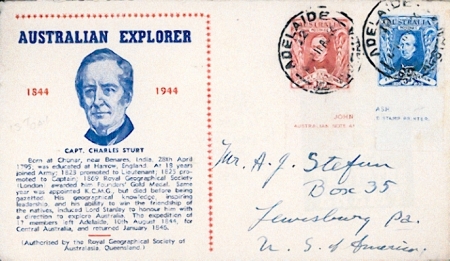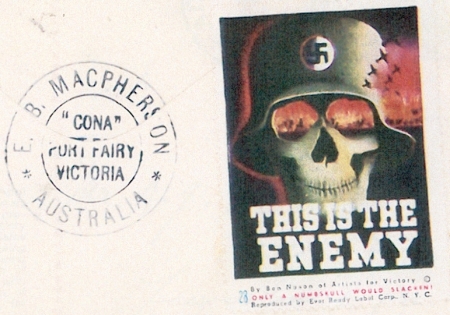This cover is a commemoration of one of Australia’s greatest explorers and it celebrates the centenary of Sturt’s third expedition in 1844 when he left Adelaide for the centre of Australia, to find the Inland Sea, hence the dates 1844-1944. It is not a first day cover for the stamps were issued 2 June1930 and were a commemoration of the centenary of Sturt’s exploration along the course of the Murray River to its outlet at the sea. The cover is of added interest in that the sender used both stamps with half of the John Ash/ Australian Note and Stamp Printer sans-serif imprint, in order to simulate the whole imprint. The red 1½d and blue 3d Sturt stamps are each postmarked ADELAIDE/ 12/ 10-P 11 AU 44/ STH AUSTRALIA and the cover is addressed to a known stamp and cover collector in Lewisburg, Pennsylvania (Figure 1).

Charles Sturt rates five pages in the on-line Australian Dictionary of Biography, which is too much information for this paper. I have cobbled together from several sources a potted version of his life. He was born on April 1795 in India, as his father was serving as a judge there. When he was five he was sent to relatives in England to go to school. When he turned eighteen he became a junior officer in the army. In 1826 he became a captain, and he took convicts to Australia. When he arrived in Sydney in May 1827 he joined the staff of Governor Darling. He became bored of his government duties and decided he wanted to go exploring instead. He got permission from Governor Darling to lead an expedition to follow the Macquarie River.
His first expedition was in November 1828 when he set off with Hamilton Hume as second in command. They followed the Macquarie River until they found what Sturt called “a noble river”, and they named it the Darling after the Governor of New South Wales.
Sturt’s next expedition was to follow the course of the Lachlan-Murrumbidgee river system, which started in November 1829. He and his party traveled by boat, and in January 1930, they floated off the Murrumbidgee onto another river, the Murray River. Sturt named it after Sir George Murray, the British Secretary of State for the colonies and on the same expedition he discovered the junction of the Murray and the Darling rivers.
On a third expedition in 1844 he led an expedition into the middle of Australia, as he thought there was an Inland Sea. He started out from Adelaide and the expedition wasn’t easy. They had problems with food shortage, and at one point of the journey, the daily food for each person was only some flour and a little bit of tea. They also had problems with scurvy, extreme sunburn, and sight loss.
Sturt reckoned that he had got within 150km of the centre of Australia, but Sturt couldn’t make it any further so the team headed back to Adelaide. One major thing that they found out on that expedition, there was no inland sea. Sturt is also known for treating the Aborigines with respect, even giving them gifts, which was uncommon at the time.
After that expedition, Sturt held government appointments and he never attempted another expedition again. Sturt started suffering from sight loss from the bright sun of the desert, and soon after, he retired and went back to England in March 1853, where he died in 1869 at his home in Cheltenham.
I have purposely refrained from showing the reverse of the cover up to this point which was sent by E.B. Macpherson, Cona, Port Fairy,Victoria for I have never seen this propaganda vignette on an Australian cover before (Figure 2).
